Sustainable Knowledge-Based Enterprise Products Using AI-Powered Social Media for Enhancing Brand Equity: A Scientometric Review
Abstract
1. Introduction
2. Methodology
2.1. Theoretical Foundation
2.2. Data Source Selection
2.3. Search Strategy
2.4. Article Screening and Selection
- In the first round of the search, the dataset was refined by incorporating keywords related to KBEs, such as “company,” “enterprise,” “knowledge-based company,” “KBE,” “startup,” and “start-up,” and limiting the timeframe to 2008–2024 to focus on contemporary research. Inclusion criteria required articles to address brand equity and social media, while exclusion criteria removed irrelevant sources, such as those in technical engineering, books, or conference proceedings. In this stage, 400 articles were identified.
- In the second round of the search, the focus was narrowed to English-language journal articles published between 2018 and 2024, prioritizing studies that addressed sustainability, which emerged as a critical construct for RQ2. This process resulted in 149 articles.
- In the third round of the search, a detailed full-text review was conducted to confirm direct relevance to brand equity, social media, sustainability, and KBEs, leading to the selection of 33 key articles for in-depth analysis. This helped to extract key data and significant findings from the selected articles. Factors influencing brand equity were identified and extracted from these studies to inform the development of the initial model.
2.5. Bibliometric Analysis
2.6. Thematic Analysis
2.7. Trend Analysis
2.8. Analysis and Preliminary Model Development
2.9. Methodological Rigor
- Transparency: All search strings, screening criteria, and analytical processes are clearly documented.
- Replicability: Standardized tools (Scopus, VOSviewer, NVivo) and well-defined protocols enable study replication.
- Validity: Triangulation of bibliometric, thematic, and trend analyses ensures robust, cross-validated findings.
- Relevance: The focus on recent, high-quality articles and emergent themes, such as sustainability, addresses current research needs.
3. Analysis and Findings
3.1. Scopus Data Analysis
3.1.1. Initial Dataset of Articles
3.1.2. Article Screening and Filtering
- Articles published in the last six years.
- Studies written in English for accessibility and review purposes.
- Journal articles, excluding books and conference papers, to maintain focus on scholarly publications.
- Articles published from 1994 to early 2024 were extracted and reviewed. Using VOSviewer software, the data were organized and analyzed, creating a bibliographic network that illustrates the key topics studied during this period.
- Interdisciplinary issues and studies were identified and extracted from the data. Subsequently, a network map connecting these topics was designed and analyzed.
- The filtered output data underwent further network analysis using VOSviewer, ensuring the accuracy and reliability of the results.
3.2. Literature Trends and Network Analysis
3.2.1. Trend Analysis from 2008 Onwards
3.2.2. Brand Equity, Sustainability, and Social Media
3.3. Google Trends Data Analysis
4. Review of Key Directions
4.1. Contextual Background, Branding Strategies, and Performance Measures
4.2. Brand Innovation in the Context of Social Media
4.3. Brand Equity and Its Key Factors
4.4. Brand Communities on Social Media
4.5. Sustainable Development in Branding
4.6. Theoretical Basis of Brand Equity
- ○
- Brand Awareness: The ability and willingness of customers to realize and recall a specific brand among competitors.
- ○
- Brand Loyalty: Customers’ commitment to repeatedly purchasing products or services and their willingness to defend the brand against competitors.
- ○
- Perceived Quality: Customers’ perceptions and judgments about the quality of a brand’s products or services.
- ○
- Brand Associations: Thoughts, feelings, and ideas that customers associate with the brand.
- ○
5. Discussion
5.1. Emerging Topics Based on the Scopus Analysis
5.2. Global Trend Analysis
5.3. Research Gaps
5.4. Research Contributions
5.5. AI-Powered Social Media and Future Research Directions
| Potential AI-Based Research Directions | Advantages or Values |
|---|---|
| Collaboration between humans and AI using AI agents. | SMEs can compete more effectively with larger companies. |
| Developing AI tools tailored explicitly to SME needs, target audiences, and micro-segments within their audience. | AI affects SME B2B social media strategies and offers personalized customer experiences. Enhances AI-driven customization [2]. |
| Generating new content and client engagement. | The effect of AI on the global reach of SMEs through social media. |
6. Conclusions
6.1. Implications
6.2. Review Limitations
Funding
Institutional Review Board Statement
Informed Consent Statement
Data Availability Statement
Conflicts of Interest
References
- Sun, M.; Kim, J. Sustainability and Brand Equity: The Moderating Role of Brand Color and Brand Gender. Sustainability 2023, 15, 8908. [Google Scholar] [CrossRef]
- Teepapal, T. AI-driven personalization: Unraveling consumer perceptions in social media engagement. Comput. Hum. Behav. 2025, 165, 108549. [Google Scholar] [CrossRef]
- Magableh, I.K.; Mahrouq, M.H.; Ta’Amnha, M.A.; Riyadh, H.A. The Role of Marketing Artificial Intelligence in Enhancing Sustainable Financial Performance of Medium-Sized Enterprises Through Customer Engagement and Data-Driven Decision-Making. Sustainability 2024, 16, 11279. [Google Scholar] [CrossRef]
- Indrasari, M.; Syamsudin, N.; Tampubolon, L.R.R.U. Enhancing SME product brand equity in the digital age as strategic approaches in the era of artificial intelligence. Int. J. Bus. Law Educ. 2024, 5, 1139–1152. [Google Scholar] [CrossRef]
- Hue, T.T.; Hung, T.H. Impact of artificial intelligence on branding: A bibliometric review and future research directions. Humanit. Soc. Sci. Commun. 2025, 12, 209. [Google Scholar] [CrossRef]
- Schwaeke, J.; Peters, A.; Kanbach, D.K.; Kraus, S.; Jones, P. The new normal: The status quo of AI adoption in SMEs. J. Small Bus. Manag. 2025, 63, 1297–1331. [Google Scholar] [CrossRef]
- Bevilacqua, S.; Masárová, J.; Perotti, F.A.; Ferraris, A. Enhancing top managers’ leadership with artificial intelligence: Insights from a systematic literature review. Rev. Manag. Sci. 2025, 19, 2899–2935. [Google Scholar] [CrossRef]
- Thimothy, S. How Traditional Marketing Is Failing Startups. 2016. Available online: https://www.forbes.com/sites/forbesagencycouncil/2016/04/04/how-traditional-marketing-is-failing-startups/?sh=665f06817c66 (accessed on 4 September 2025).
- Aaker, D.A. Managing Brand Equity: Capitalizing on the Value of a Brand Name; Simon and Schuster: New York, NY, USA, 2009. [Google Scholar]
- Lieven, T.; Lieven, T. Global Branding with Brand Gender and Brand Equity. In Brand Gender: Increasing Brand Equity Through Brand Personality; Palgrave Macmillan: Cham, Switzerland, 2018; pp. 33–61. [Google Scholar]
- Bader, M.; Jayaraman, R.; Antony, J.; Goonetilleke, R.S.; Linderman, K.; Hoerl, R. Mitigating process improvement project failures: Leveraging organizational responses and lessons learned. Benchmarking Int. J. 2024. [Google Scholar] [CrossRef]
- Pritchard, M.P.; Stinson, J.L. Leveraging Brands in Sport Business; Routledge: Oxfordshire, UK, 2013. [Google Scholar]
- Manzoor, A.; Shaikh, K.A. Brand equity and purchase intention: The Indian automobile industry. Pak. Bus. Rev. 2016, 18, 635–654. [Google Scholar]
- Wright, L.T.; Moutinho, L.; Stone, M.; Bagozzi, R.P. The Routledge Companion to Marketing Research; Routledge: Oxfordshire, UK, 2021. [Google Scholar]
- Machado, J.C.; Martins, C.C.; Ferreira, F.C.; Silva, S.C.; Duarte, P.A. Motives to engage with sports brands on Facebook and Instagram—The case of a Portuguese football club. Int. J. Sports Mark. Spons. 2020, 21, 325–349. [Google Scholar] [CrossRef]
- Martins, C.; Patrício, L. Company social networks: Customer communities or supplementary services? J. Serv. Mark. 2018, 32, 443–461. [Google Scholar] [CrossRef]
- Saleh, M.A.H. Social networks and customer relationship development at the Saudi telecommunication service providers. Int. J. Mark. Stud. 2016, 8, 77. [Google Scholar] [CrossRef]
- Pereira, V.; Jayawardena, N.S.; Sindhwani, R.; Behl, A.; Laker, B. Using firm-level intellectual capital to achieve strategic sustainability: Examination of phenomenon of business failure in terms of the critical events. J. Intellect. Cap. 2024, 25, 841–866. [Google Scholar] [CrossRef]
- Yin, H. Prediction Method of Consumption Behaviour on Social Network Oriented to User Mental Model. In International Conference on Advanced Hybrid Information Processing; Springer: Berlin/Heidelberg, Germany, 2022. [Google Scholar]
- Díaz-Campo, J.; Segado-Boj, F.; Fernández-Gómez, E. Hábitos del usuario y tipo de red social como predictores de consumo y difusión de noticias. El Prof. Inf. 2021, 30, e300417. [Google Scholar] [CrossRef]
- Górska-Warsewicz, H. Trust and Brand Management: The Role of Brand Heritage; Taylor & Francis: Abingdon, UK, 2024. [Google Scholar]
- Febrian, A.; Nani, D.A.; Lina, L.F.; Husna, N. The Role of Social Media Activities to Enhance Brand Equity. J. Econ. Bus. Account. Ventur. 2022, 25, 20. [Google Scholar] [CrossRef]
- Lin, K.; Du, W.; Yang, S.; Liu, C.; Na, S. The effects of social media communication and e-WOM on brand equity: The moderating roles of product involvement. Sustainability 2023, 15, 6424. [Google Scholar] [CrossRef]
- Chew, F.P. Global Dialogue on Media Dynamics, Trends and Perspectives on Public Relations and Communication: Proceedings of the International Conference on Public Relations and Media Communication, (PRMC 2024), Beijing, China, 28–30 June 2024; CRC Press: Boca Raton, FL, USA, 2025. [Google Scholar]
- Dumitriu, D.; Militaru, G.; Deselnicu, D.C.; Niculescu, A.; Popescu, M.A. A perspective over modern SMEs: Managing brand equity, growth and sustainability through digital marketing tools and techniques. Sustainability 2019, 11, 2111. [Google Scholar] [CrossRef]
- Musonda, I.; Mwanaumo, E.; Onososen, A.; Kalaoane, R. Development and Investment in Infrastructure in Developing Countries: A 10-Year Reflection; CRC Press: Boca Raton, FL, USA, 2024. [Google Scholar]
- Vivek, S.R. An Empirical Study of Measurement of Brand Equities for Selected Consumer Durable Vis-à-Vis Non-Durable Products in Western Indian Rural Market. Ph.D. Thesis, Maharaja Sayajirao University of Baroda, Vadodara, India, 2022. [Google Scholar]
- Yağan, K. Strategic Brand Management in Cosmetic Sector in Turkey. Ph.D. Thesis, Marmara Universitesi, Istanbul, Turkey, 1999. [Google Scholar]
- Gupta, R.; Kumar, V.; Kaushik, A.K.; Gupta, D.D.; Sindhwani, R. Investigating the impact of online brand communities on online customer engagement and brand loyalty. J. Glob. Mark. 2023, 36, 319–338. [Google Scholar] [CrossRef]
- Lindgreen, A.; Vanhamme, J.; Watkins, R.; Maon, F. Communicating Corporate Social Responsibility in the Digital Era; Routledge: Oxfordshire, UK, 2017. [Google Scholar]
- Williams, L. Encouraging Socially Responsible Fashion Consumption: An Investigation of the Effects of a Sustainability Index Garment Label on Consumers’ Brand Attitudes and Evaluations. Ph.D. Thesis, The University of North Carolina at Greensboro, Greensboro, NC, USA, 2023. [Google Scholar]
- Santana, C.L. Social Media Marketing on Instagram: Influences on Female Millennials’ Purchase Intentions. Master’s Thesis, University of Johannesburg, Johannesburg, South Africa, 2022. [Google Scholar]
- Miller, D. Impact of Social Media Marketing on Brand Equity in the United States. Int. J. Mark. Strateg. 2024, 6, 36–47. [Google Scholar] [CrossRef]
- de Carvalho Simões, F. Business Plan for FC Media Experience. Master’s Thesis, ISCTE-Instituto Universitario de Lisboa, Lisbon, Portugal, 2018. [Google Scholar]
- Wilson, G.; Johnson, O.; Brown, W. The Influence of Social Media Marketing on Brand Loyalty. Preprints 2024. [Google Scholar] [CrossRef]
- Tutal, B. Tüketicilerin Sosyal Medya Reklamlarına Yönelik Tutum ve Şüpheciliklerinin Marka Güveni Oluşumuna Etkisi. Ph.D. Thesis, Marmara Universitesi, Istanbul, Turkey, 2024. [Google Scholar]
- Faikoğlu, Z.K. Factors that Drive Mobile Commerce Advocacy of Generation Z. Master’s Thesis, Marmara Universitesi, Istanbul, Turkey, 2022. [Google Scholar]
- Yesiloglu, S.; Costello, J. Influencer Marketing. Building Brand Communities and Engagement; Routledge: Oxfordshire, UK, 2020. [Google Scholar]
- Gholamveisy, S.; Momen, A.; Hatami, M.; Sekhavat, M.; Homayooni, S. The effect of perceived social media marketing activities on brand loyalty. Apunt. Univ. 2023, 13, 105–118. [Google Scholar] [CrossRef]
- Falakh, M.F. Social Media Marketing Influence Analysis Brand Image: Product Quality Perception and Trust in Consumer Buying Interest in Mie Sedap Cup Products. Co-Value J. Ekon. Kop. Dan Kewirausahaan 2024, 15. [Google Scholar] [CrossRef]
- Muchungu, T.K. Essays on Digitalization and New Venture Internationalization. Ph.D. Thesis, Morgan State University, Baltimore, MD, USA, 2024. [Google Scholar]
- Dessart, L. Social media engagement: A model of antecedents and relational outcomes. J. Mark. Manag. 2017, 33, 375–399. [Google Scholar] [CrossRef]
- Pathak, A.A.; Kaushik, K. Driving consumer engagement for digital payment brands: Content strategy on instagram. J. Retail. Consum. Serv. 2024, 79, 103821. [Google Scholar] [CrossRef]
- Park, J.-S.; Ha, S. Developing brand loyalty through consumer engagement with brand communities in social media. Asian J. Bus. Res. 2021, 11, 83–102. [Google Scholar] [CrossRef]
- Monica, B.; BalaÅŸ, R. Social media marketing to increase brand awareness. J. Econ. Bus. Res. 2014, 20, 155–164. [Google Scholar]
- Faisal, A.; Ekawanto, I. The role of social media marketing in increasing brand awareness, brand image and purchase intention. Indones. Manag. Account. Res. 2021, 20, 185–208. [Google Scholar] [CrossRef]
- Yuan, C. Research on Social Media and Enterprise Brand Marketing Innovation. Int. J. Front. Sociol. 2023, 5, 47–51. [Google Scholar] [CrossRef]
- Nguyen, T. Differential Absorptive Capacities, Ambidexterity & New Product Creativity: A Longitudinal Investigation of US High Technology SMEs from the Attention-Based Perspective; Cardiff University: Cardiff, UK, 2015. [Google Scholar]
- Patrick, M.J. Social Media Marketing Tools and Strategies in Small Business. Ph.D. Thesis, Trident University International, Cypress, CA, USA, 2022. [Google Scholar]
- Chalmeta, R.; Barbeito-Caamaño, A.M. Framework for using online social networks for sustainability awareness. Online Inf. Rev. 2024, 48, 334–353. [Google Scholar] [CrossRef]
- Tanaka, Y.; Huang, L. Enhancing social media engagement in Japan: An empirical study of design and content factors on brand account. Int. J. Mark. Distrib. 2024, 27, 53–72. [Google Scholar] [CrossRef]
- Handoyo, S. Purchasing in the digital age: A meta-analytical perspective on trust, risk, security, and e-WOM in e-commerce. Heliyon 2024, 10, e29714. [Google Scholar] [CrossRef] [PubMed]
- Moran, G.; Muzellec, L.; Johnson, D. Message content features and social media engagement: Evidence from the media industry. J. Prod. Brand Manag. 2020, 29, 533–545. [Google Scholar] [CrossRef]
- Aslam, S.; Hussain, B.; Hussain, S. The influence of social media on entrepreneurial identity and self-presentation. J. Media Entrep. 2024, 4, 97–106. [Google Scholar] [CrossRef]
- Ekinci, Y.; Japutra, A.; Molinillo, S.; Uysal, M. Extension and validation of a novel destination brand equity model. J. Travel Res. 2023, 62, 1257–1276. [Google Scholar] [CrossRef]
- Şahin, B.; Özkan, E.; Yeşilırmak, S. Brand Equity in Frito Lay Chips: An Exploratory Research on Turkish Young Consumers in COVID-19 Days. Int. J. Bus. Soc. Sci. 2020, 11. [Google Scholar] [CrossRef]
- Amoako, K.; Boateng, E. Analysis of the effectiveness of corporate social responsibility in brand marketing with AAKER brand equity and daisy wheel models. Technium Soc. Sci. J. 2022, 30, 484. [Google Scholar] [CrossRef]
- Gaston, M. Differentiation and Performance of US Casual Restaurant Brands Through COVID-19: A Quantitative Correlational Study. Ph.D. Thesis, University of Phoenix, Phoenix, AZ, USA, 2024. [Google Scholar]
- Gutiérrez-Rodríguez, P. Purchase intention of fashion brand retailers: A journey through consumer engagement and happiness. Manag. Decis. 2024, 62, 381–402. [Google Scholar] [CrossRef]
- Kietzmann, J.H.; Hermkens, K.; McCarthy, I.P.; Silvestre, B.S. Social media? Get serious! Understanding the functional building blocks of social media. Bus. Horiz. 2011, 54, 241–251. [Google Scholar] [CrossRef]
- Kufakunesu, F. Building Customer-Based Brand Equity Through Facebook Brand Communities. Ph.D. Thesis, University of Johannesburg, Johannesburg, South Africa, 2024. [Google Scholar]
- Paliszkiewicz, J.; Dąbrowski, I.; Halawi, L. Trust in Generative Artificial Intelligence: Human-Robot Interaction and Ethical Considerations; Taylor & Francis: Abingdon, UK, 2025. [Google Scholar]
- Sharabati, A.-A.A.; Ali, A.A.A.; Allahham, M.I.; Hussein, A.A.; Alheet, A.F.; Mohammad, A.S. The Impact of Digital Marketing on the Performance of SMEs: An Analytical Study in Light of Modern Digital Transformations. Sustainability 2024, 16, 8667. [Google Scholar] [CrossRef]
- Abdi, A.; Rohmah, I.Y. Harnessing Technology for Marketing Success: A Case Study in the Culinary Tourism Sector. Daengku J. Humanit. Social. Sci. Innov. 2024, 4, 1060–1069. [Google Scholar] [CrossRef]
- Al-Sartawi, A.M.M.; Nour, A.I. Artificial Intelligence and Economic Sustainability in the Era of Industrial Revolution 5.0; Springer Nature: Berlin/Heidelberg, Germany, 2024; Volume 528. [Google Scholar]
- Paliszkiewicz, J.; Gołuchowski, J.; Zdanowicz-Cyganiak, K.; Chen, K. Trust, Media and the Economy: Mutual Relations; Taylor & Francis: Abingdon, UK, 2025. [Google Scholar]
- Smith, M.W. A New Model of Alumni-Perceived Higher Education Brand Equity Evaluation and Outcomes. Ph.D. Thesis, University of Pennsylvania, Philadelphia, PA, USA, 2020. [Google Scholar]
- Mosa, A.A.A. Value Co-Creation Through Social Media Platforms in Hotel Industry: Constructivist Grounded Theory. Ph.D. Thesis, The British University in Dubai, Dubai, United Arab Emirates, 2022. [Google Scholar]
- Mohammadi, A. Intervening Role of Loyalty Reward Programs and E-Word-of-Mouth on Smartphone Brand Loyalty in Malaysia. Ph.D. Thesis, Universiti Putra Malaysia, Serdang, Malaysia, 2019. [Google Scholar]
- Mohamed, A.A.A. The Role of Social Media Marketing Activities on Customer Engagement and Its Influence on Customer’s Purchase Intention and Price Premium: An Empirical Study in the Luxury Fashion Market. Ph.D. Thesis, Universidade do Minho, Braga, Portugal, 2023. [Google Scholar]
- Khan, M.; Ahmad, M.; Alidjonovich, R.D.; Bakhritdinovich, K.M.; Turobjonovna, K.M.; Odilovich, I.J. The impact of cultural factors on digital marketing strategies with Machine learning and honey bee Algorithm (HBA). Cogent Bus. Manag. 2025, 12, 2486590. [Google Scholar] [CrossRef]
- Ali, A.S.; Maelah, R. Technological Innovation and Sustainability of Shared Service: Insights from Industry Players. Heliyon 2025, 11. [Google Scholar] [CrossRef] [PubMed]
- Sheykhan, S.; Boozary, P.; GhorbanTanhaei, H.; Behzadi, S.; Rahmani, F.; Rabiee, M. Creating a fuzzy DEMATEL-ISM-MICMAC-fuzzy BWM model for the organization’s sustainable competitive advantage, incorporating green marketing, social responsibility, brand equity and green brand image. Sustain. Futures 2024, 8, 100280. [Google Scholar] [CrossRef]
- Zhang, J.; Yang, Z.; He, B. Does digital infrastructure improve urban economic resilience? Evidence from the Yangtze River Economic Belt in China. Sustainability 2023, 15, 14289. [Google Scholar] [CrossRef]
- Blut, M.; Wünderlich, N.V.; Brock, C. Facilitating retail customers’ use of AI-based virtual assistants: A meta-analysis. J. Retail. 2024, 100, 293–315. [Google Scholar] [CrossRef]
- Alhitmi, H.K.; Mardiah, A.; Al-Sulaiti, K.I.; Abbas, J. Data security and privacy concerns of AI-driven marketing in the context of economics and business field: An exploration into possible solutions. Cogent Bus. Manag. 2024, 11, 2393743. [Google Scholar] [CrossRef]
- Saura, J.R.; Škare, V.; Dosen, D.O. Is AI-based digital marketing ethical? Assessing a new data privacy paradox. J. Innov. Knowl. 2024, 9, 100597. [Google Scholar] [CrossRef]
- Gorenc, N. AI embedded bias on social platforms. Int. Rev. Sociol. 2025, 1–20. [Google Scholar] [CrossRef]
- Silva, S.; Kenney, M. Algorithms, platforms, and ethnic bias: An integrative essay. Phylon (1960-) 2018, 55, 9–37. [Google Scholar]
- Gharaibeh, M.; Alamarnih, E.; Gharaibeh, M.A. Improving Verbal and Leadership Skills in Gifted Sixth Graders: An Intervention Evaluation in the United Arab Emirates. Int. J. Divers. Educ. 2025, 25, 23. [Google Scholar] [CrossRef]
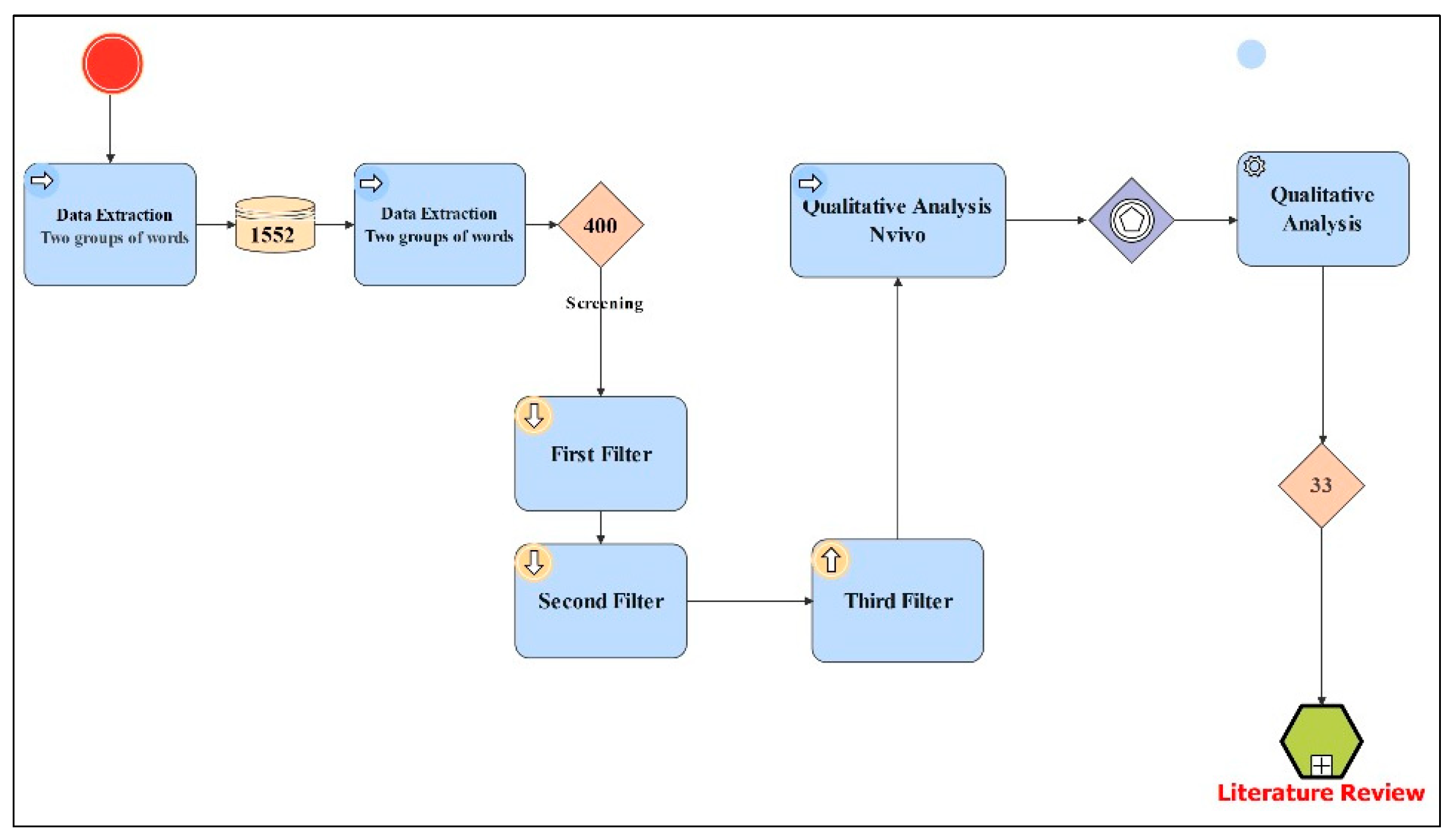
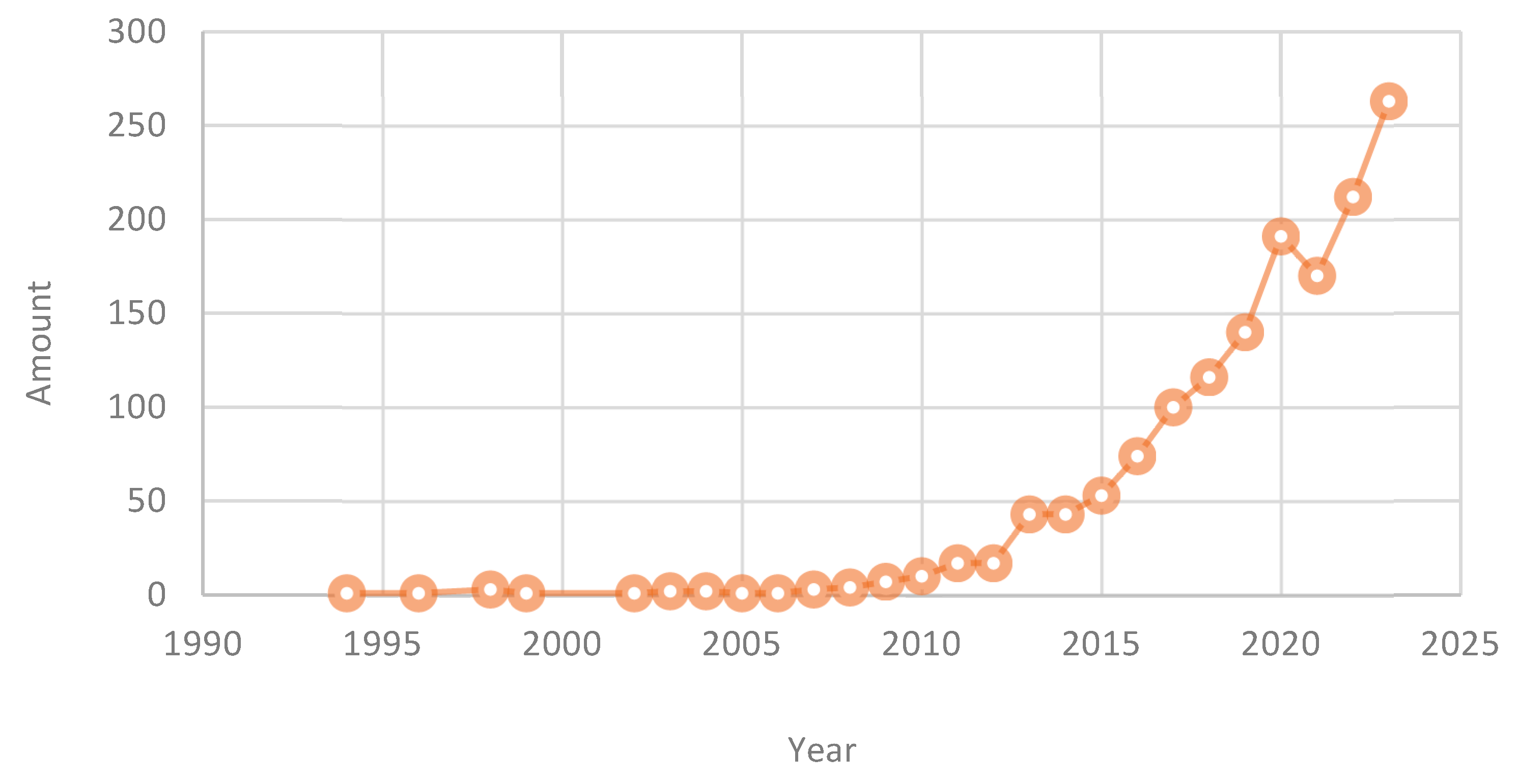
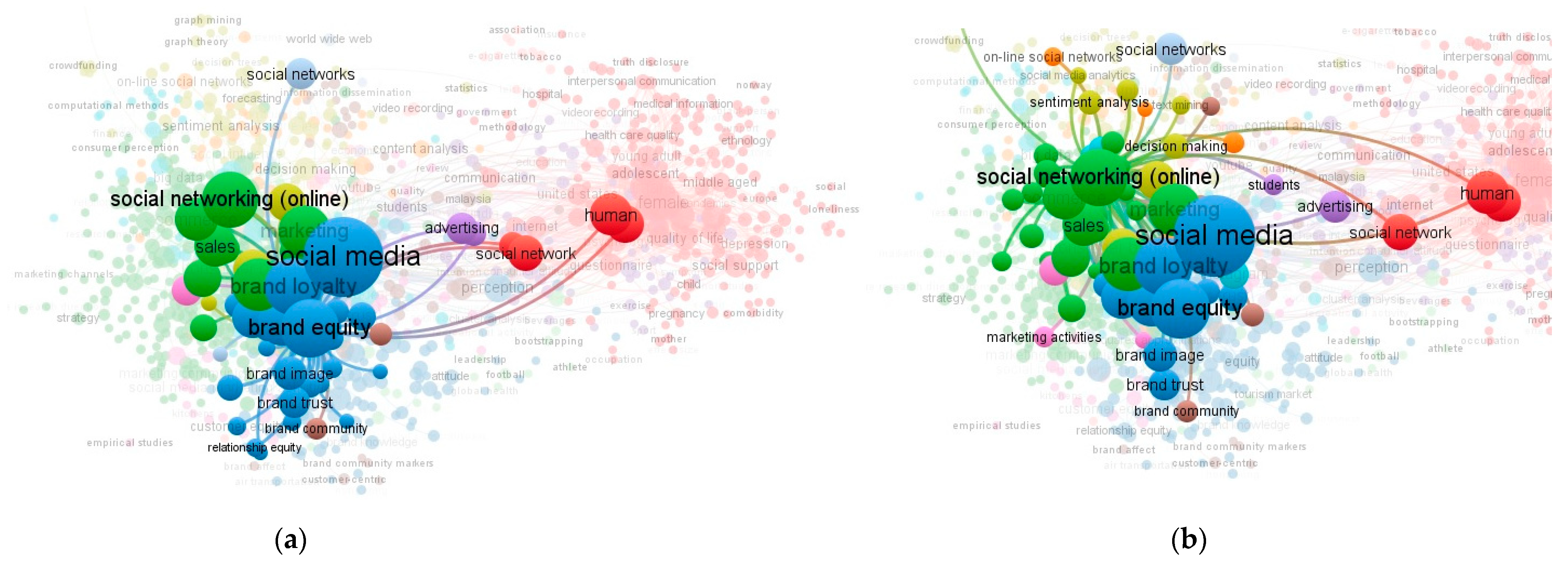
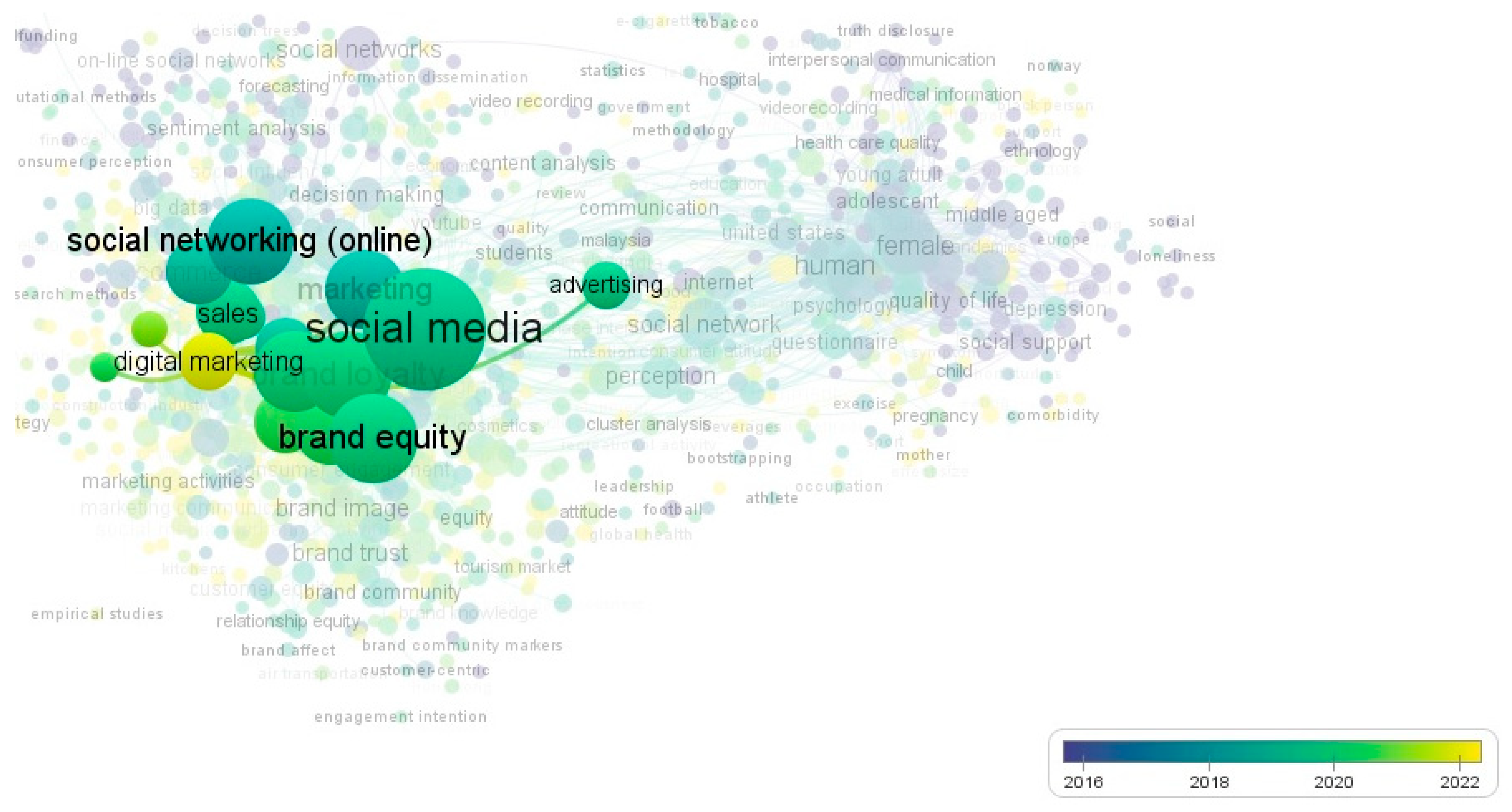
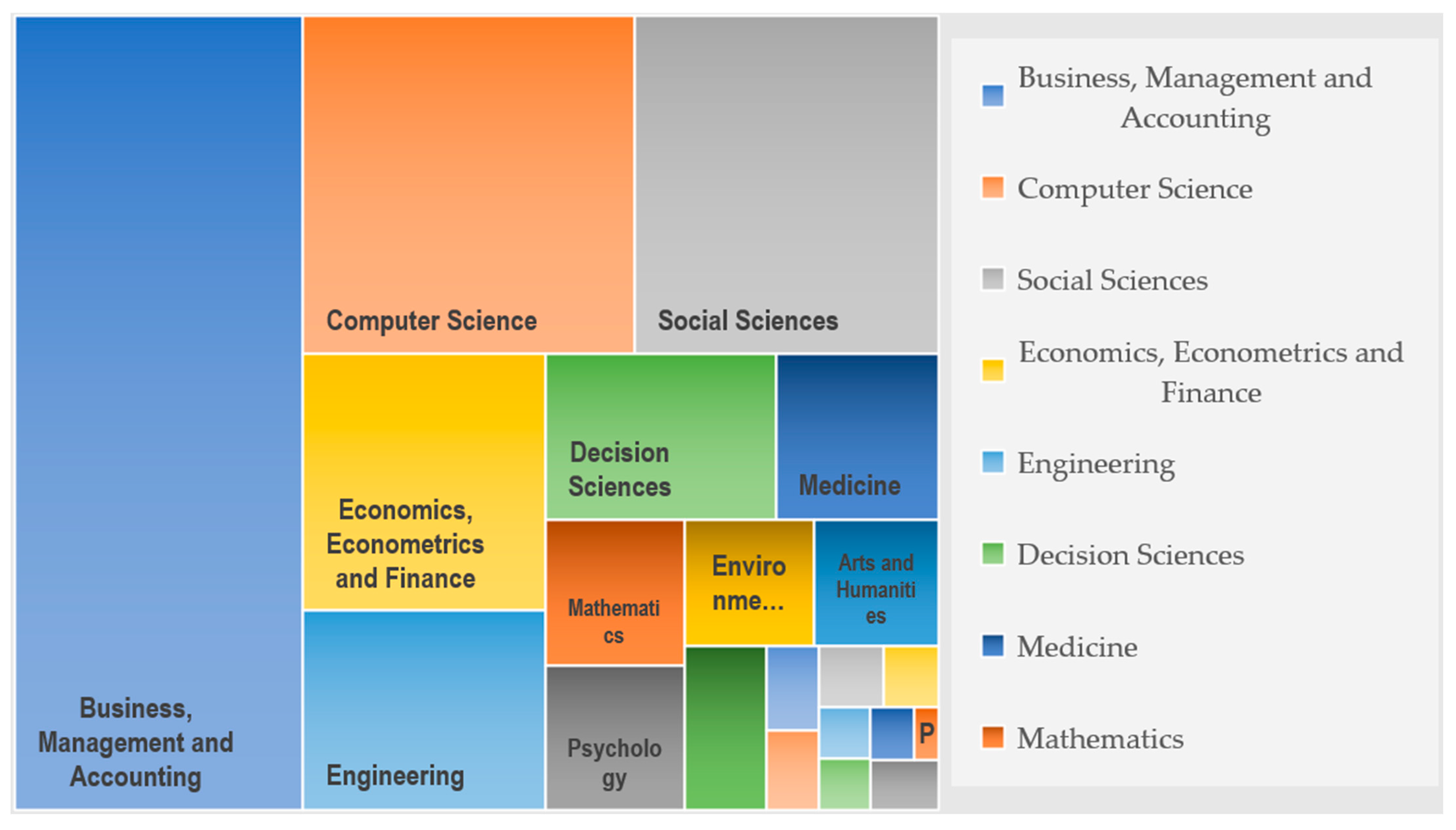
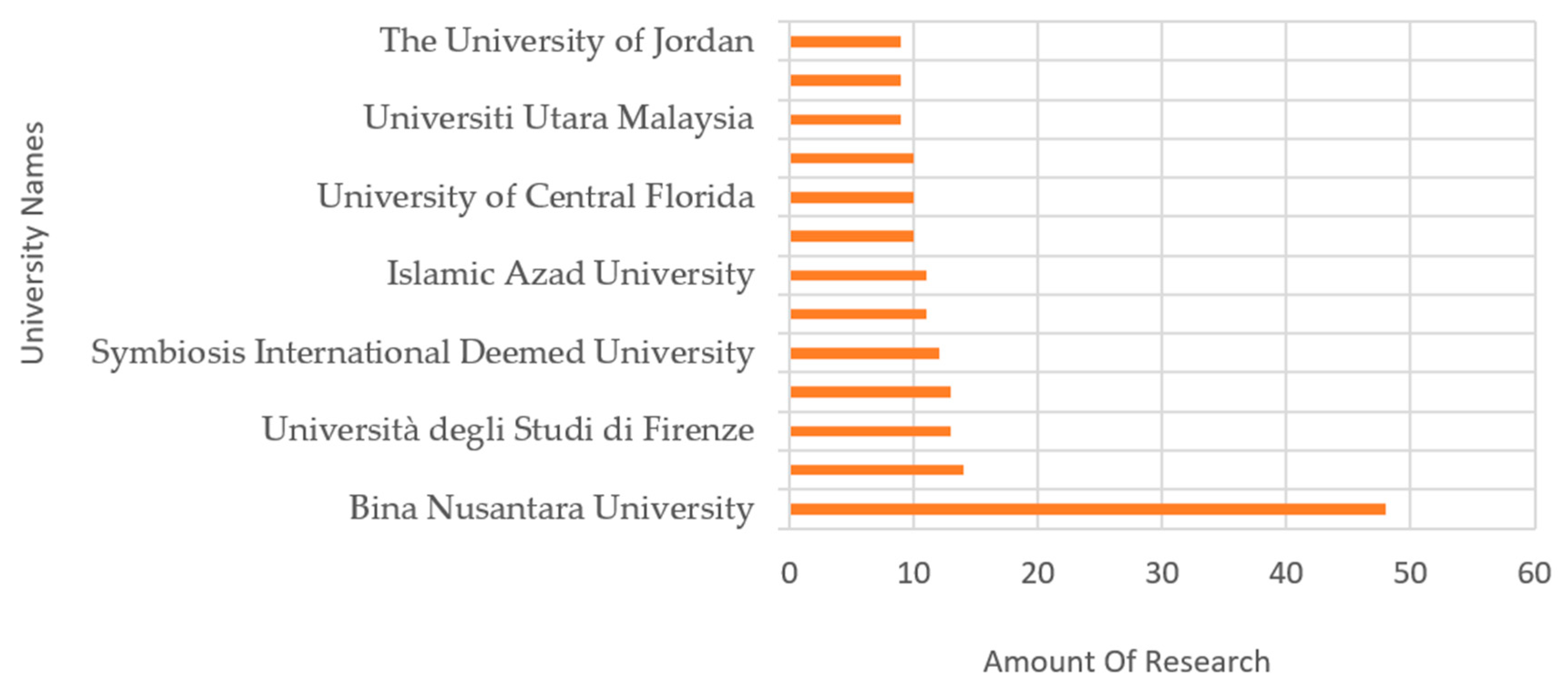
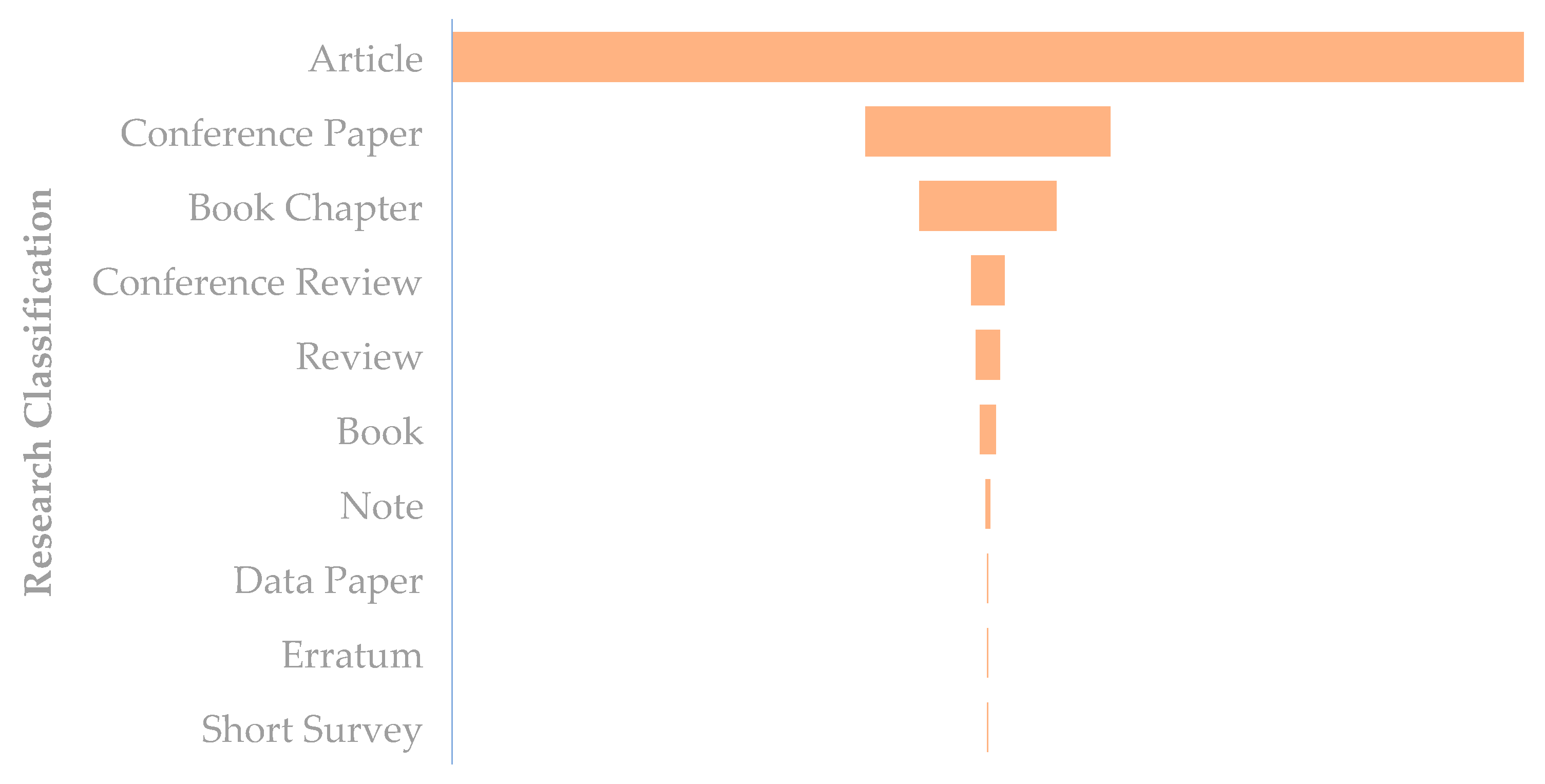

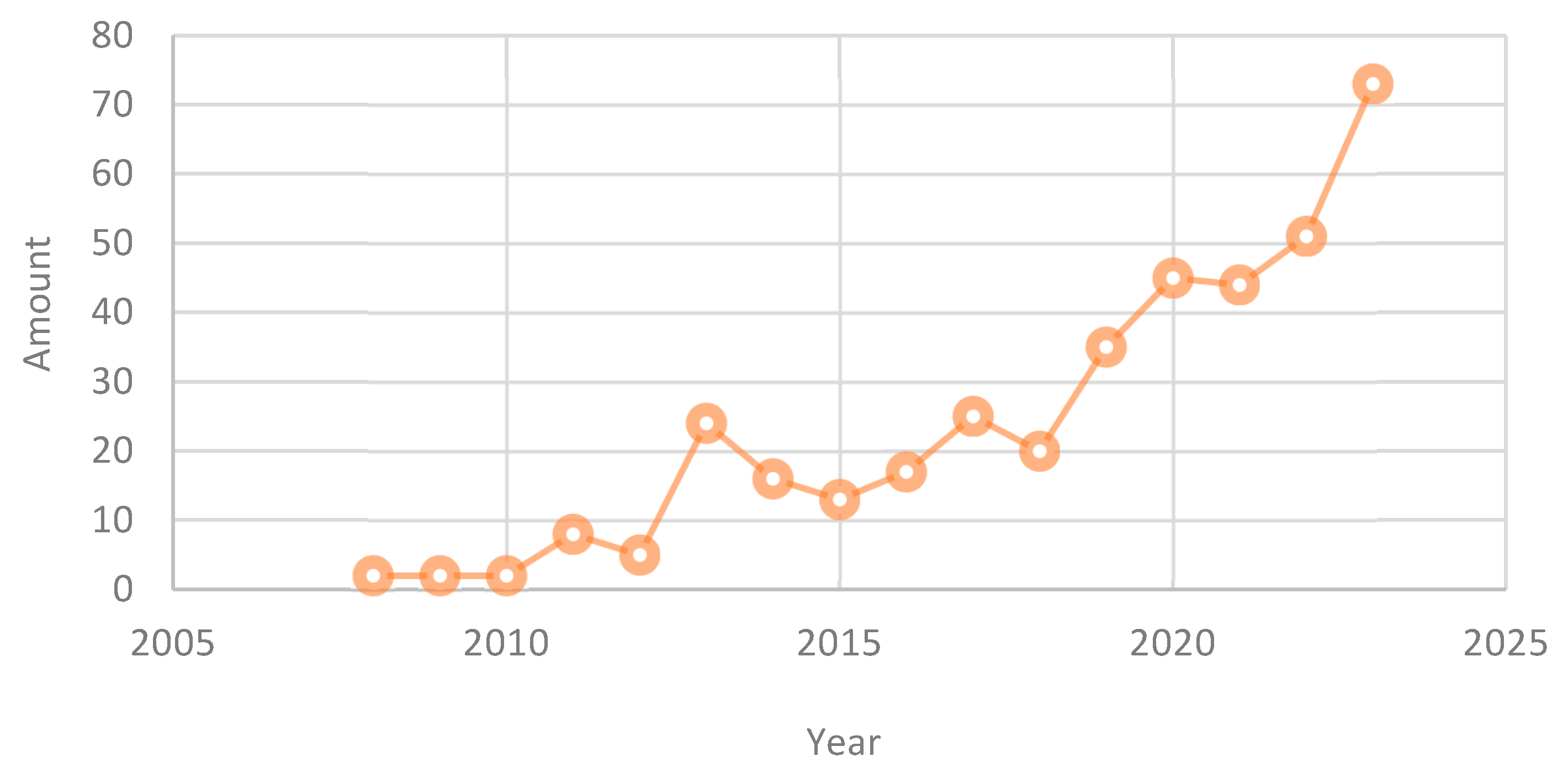
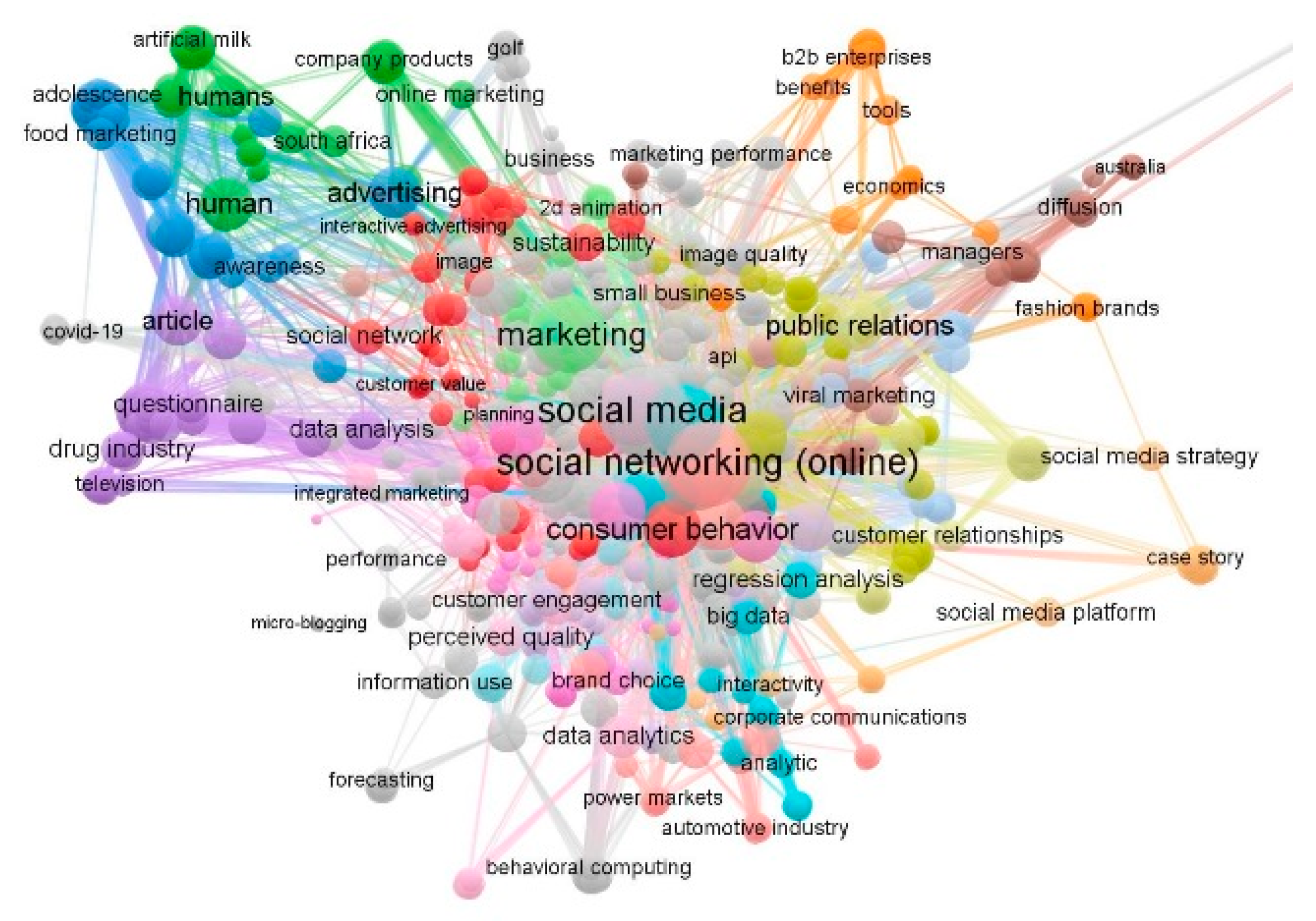
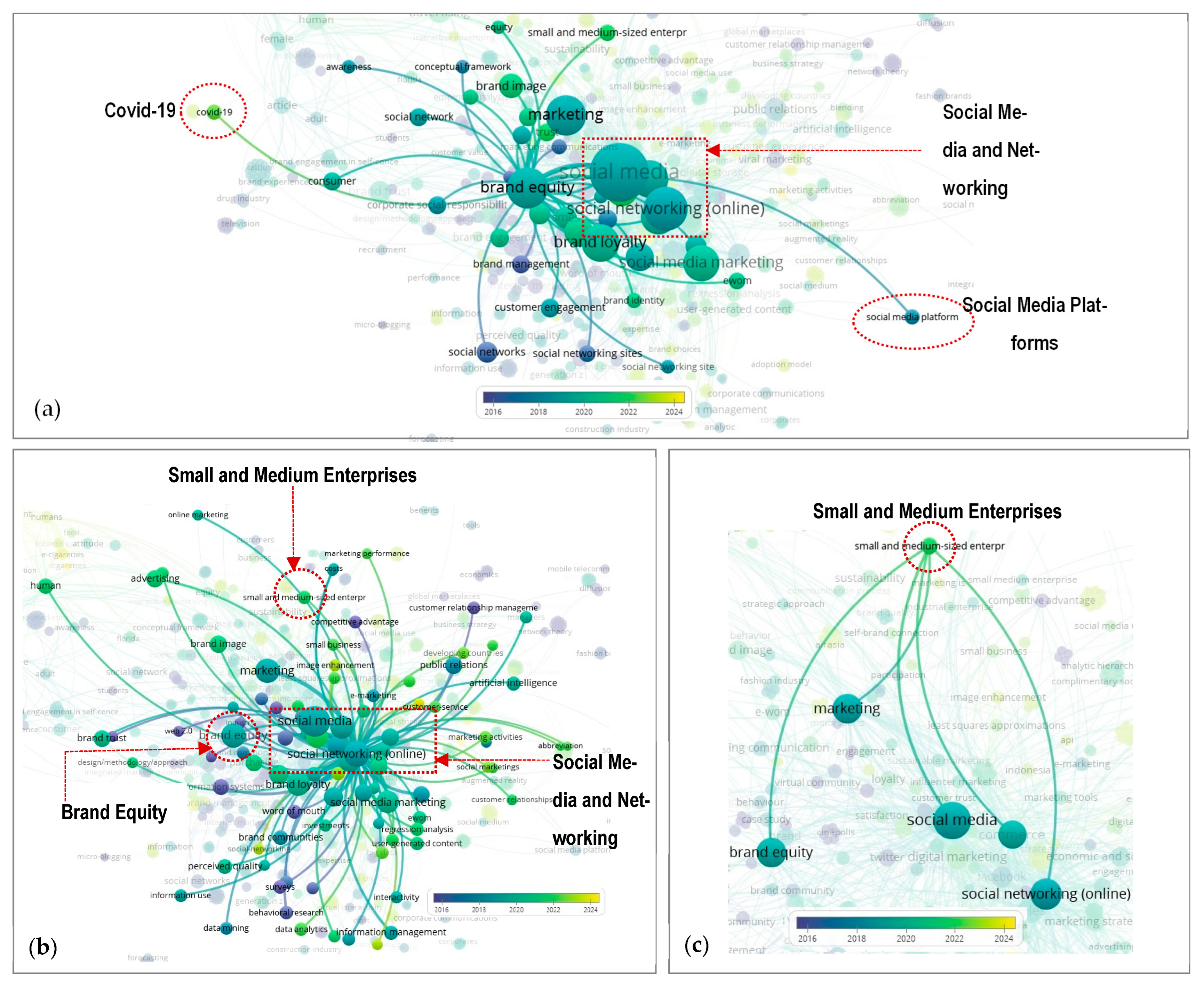
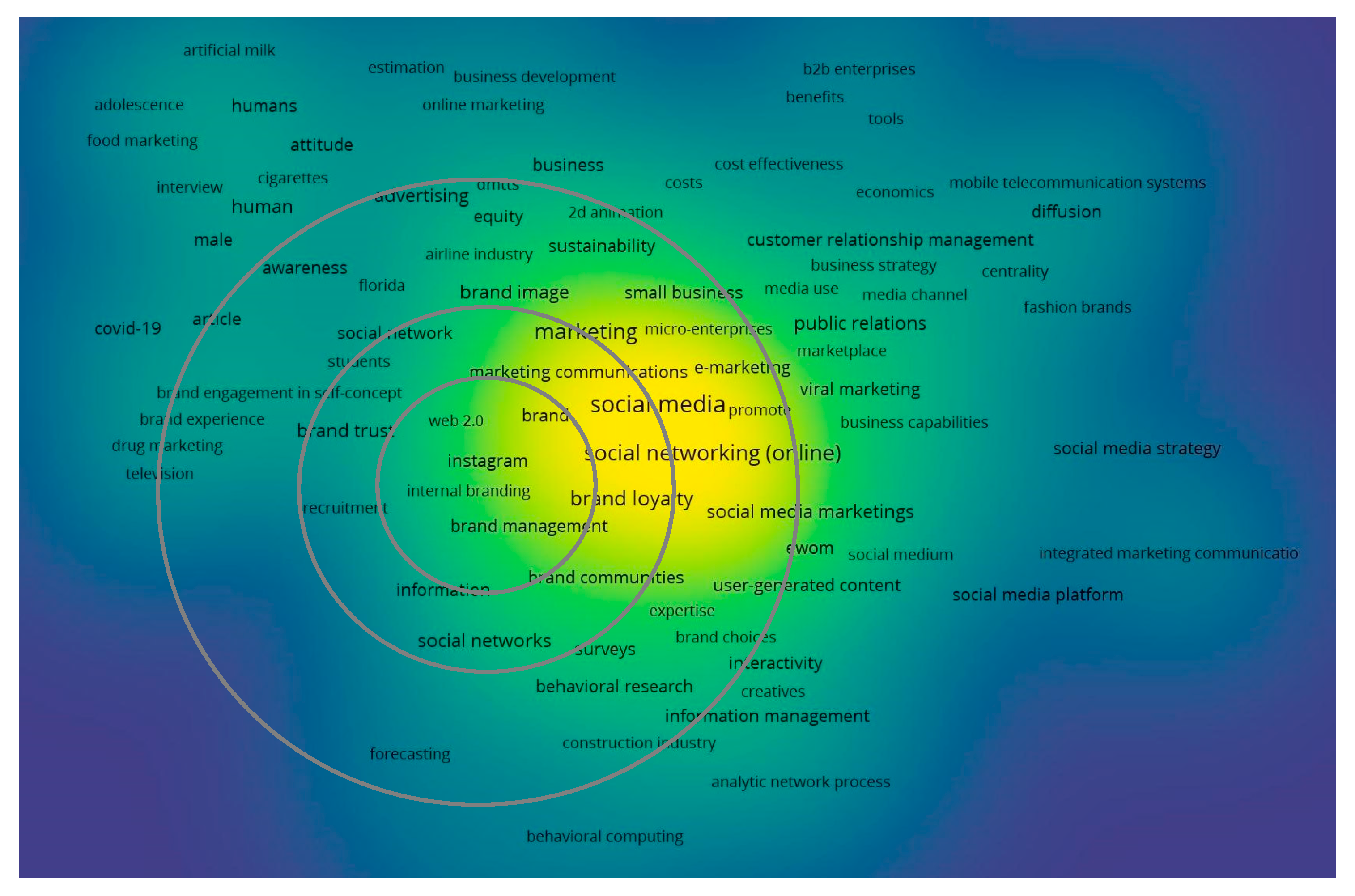

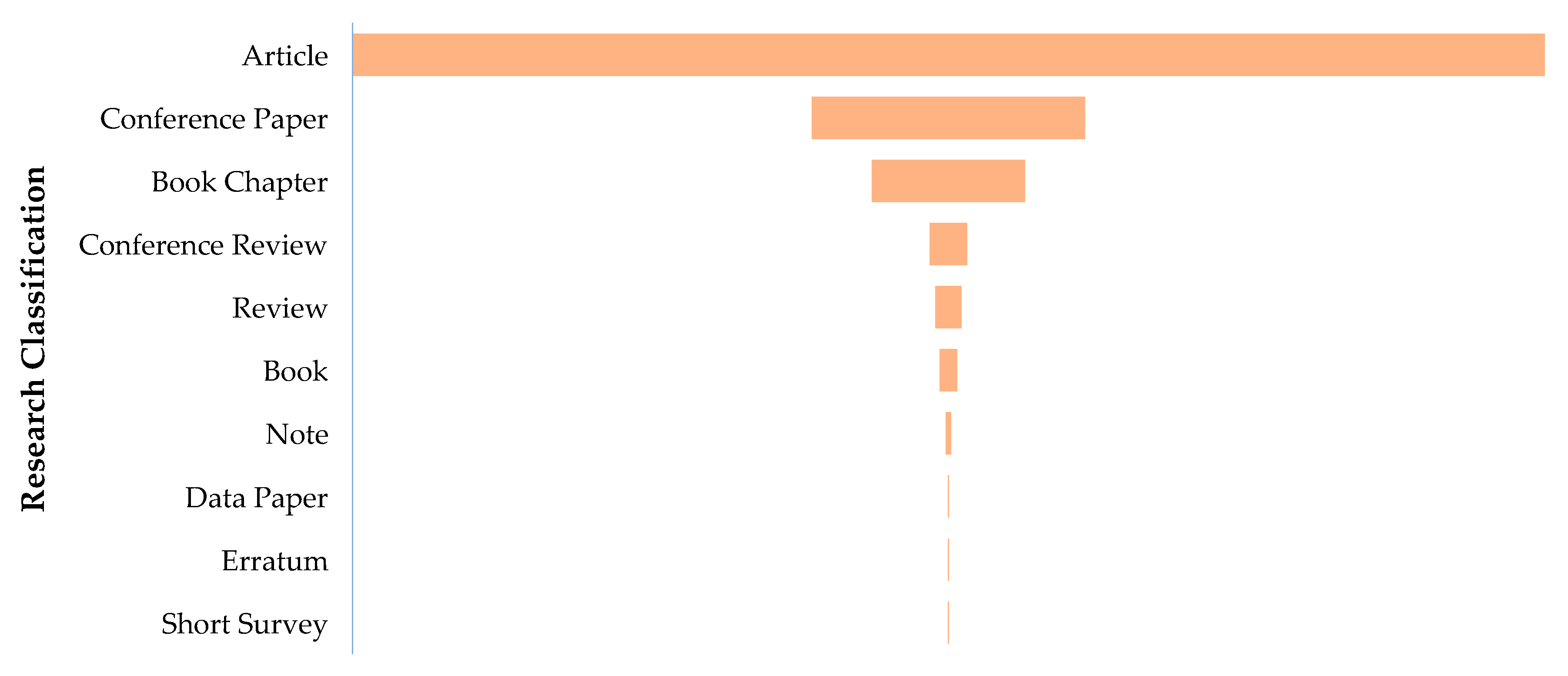
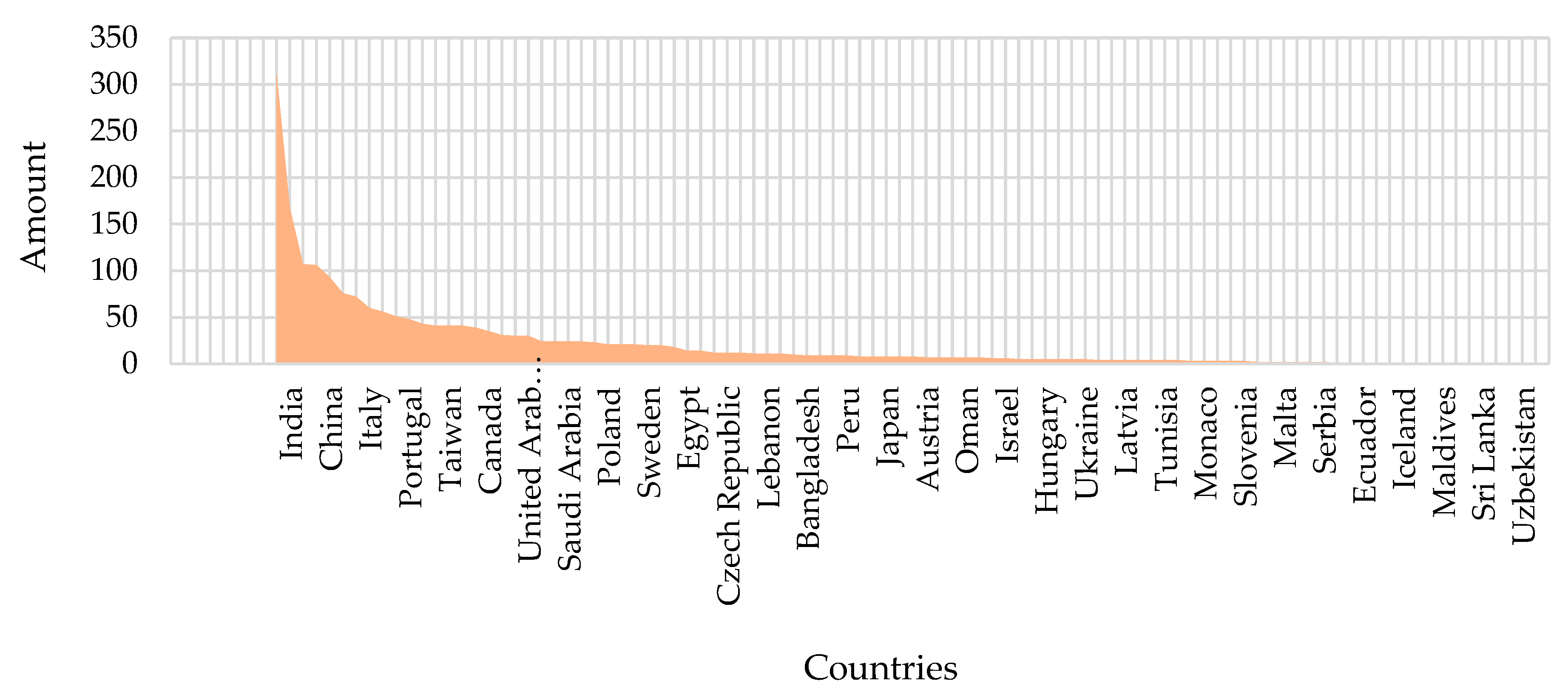
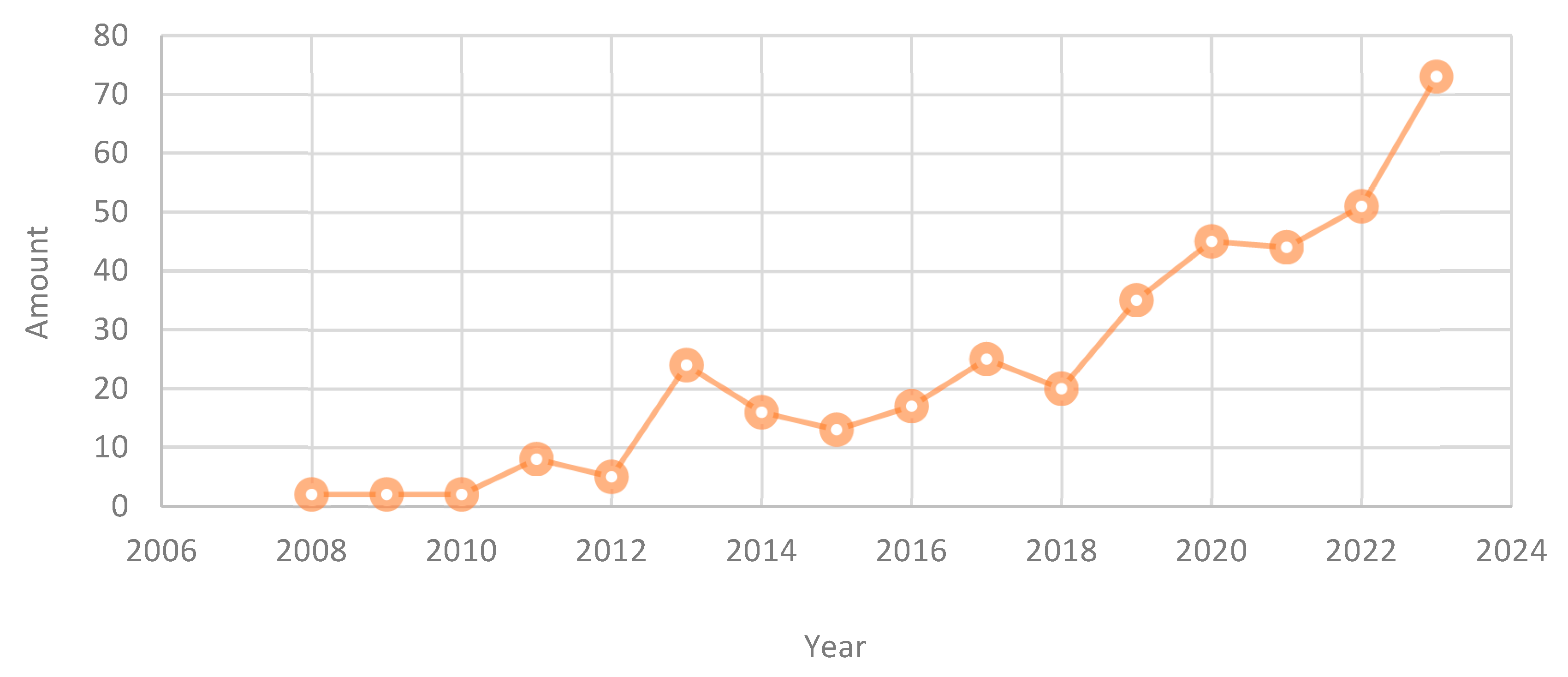

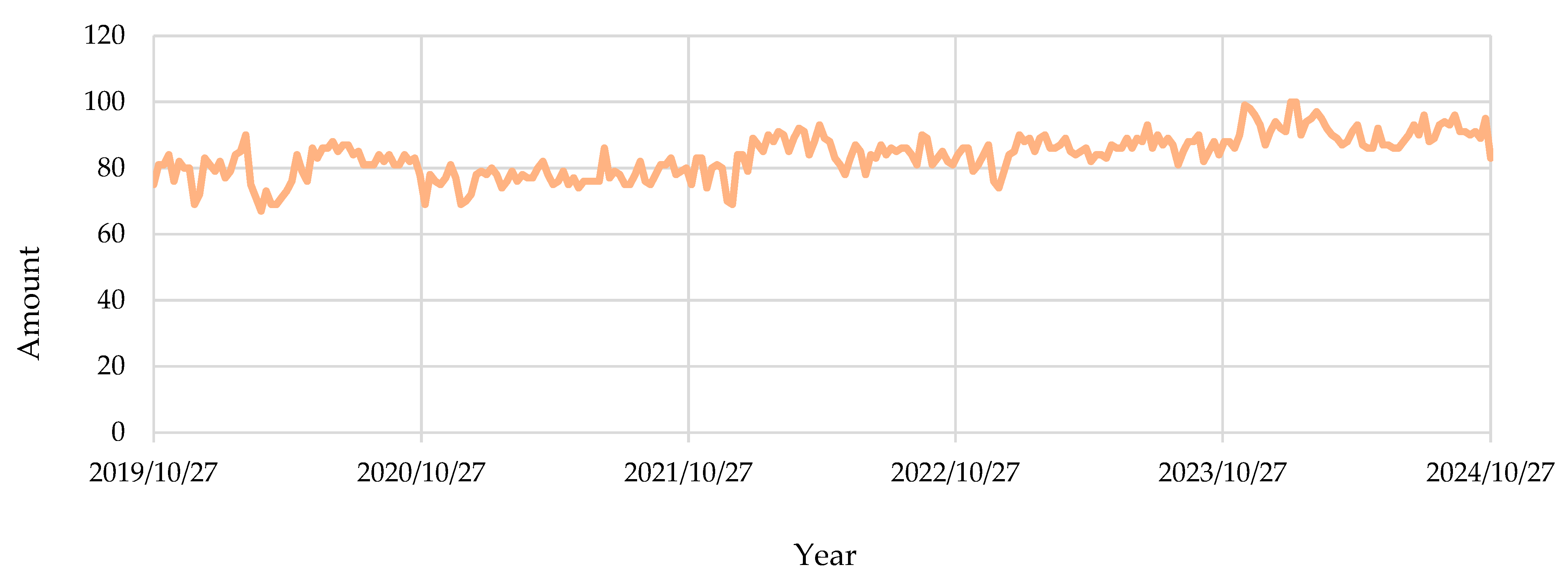
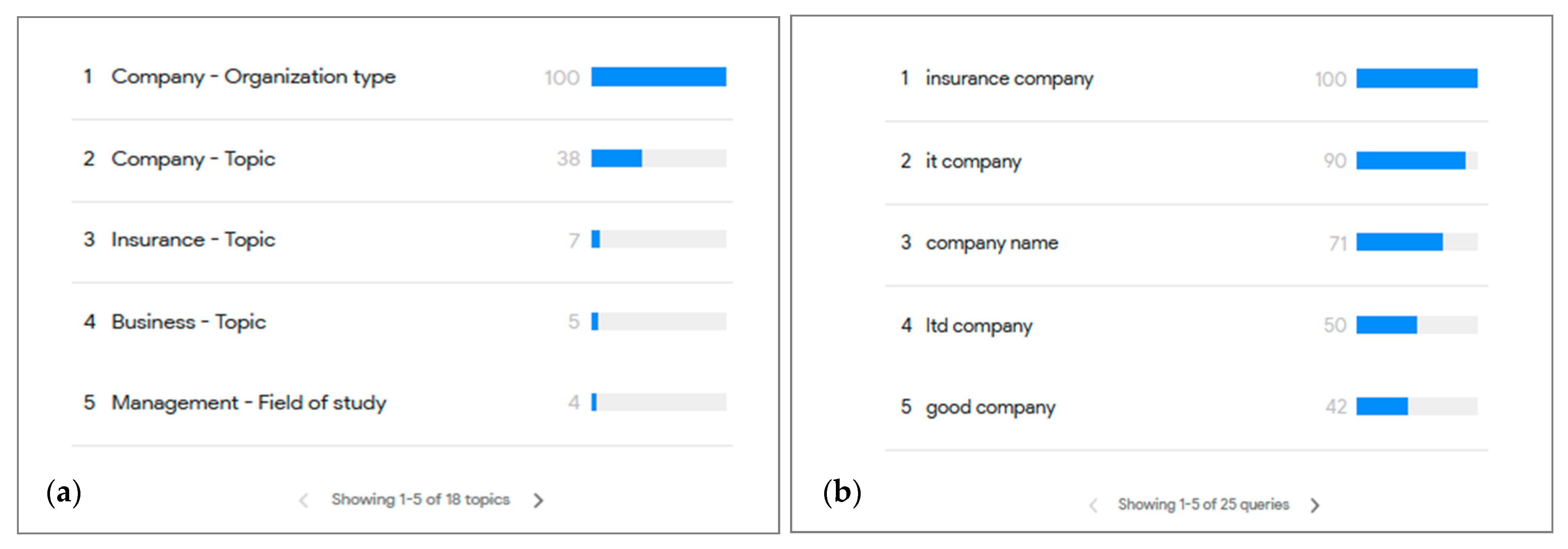
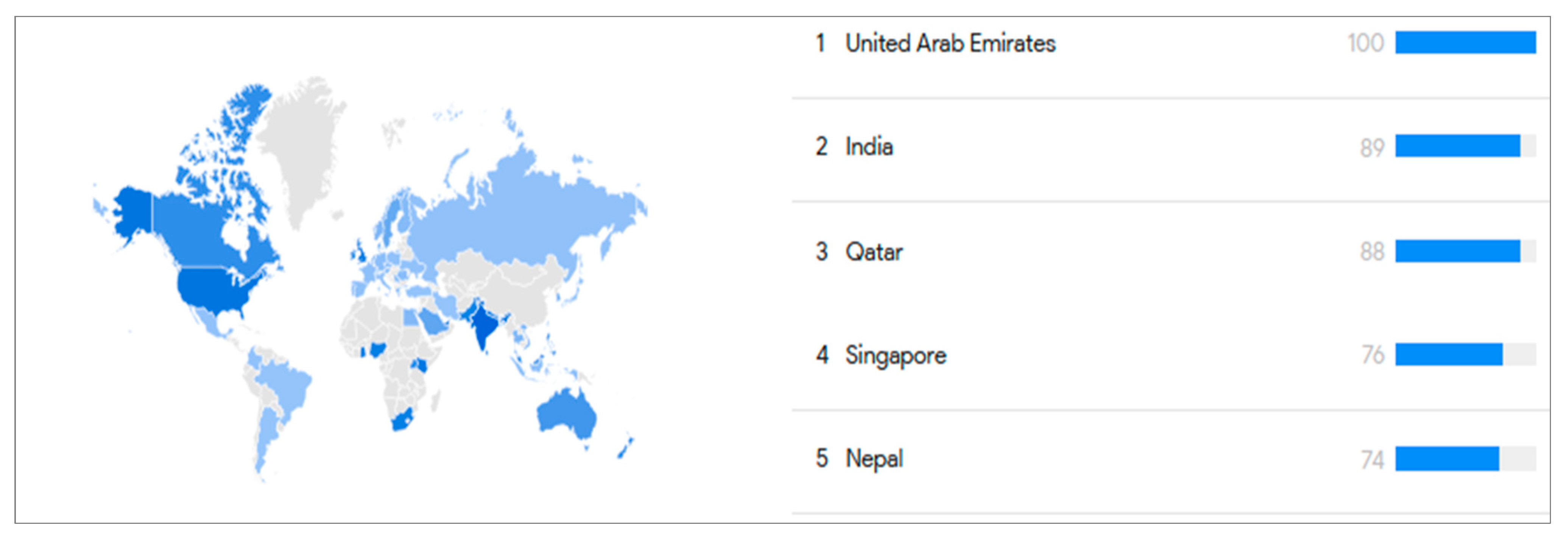
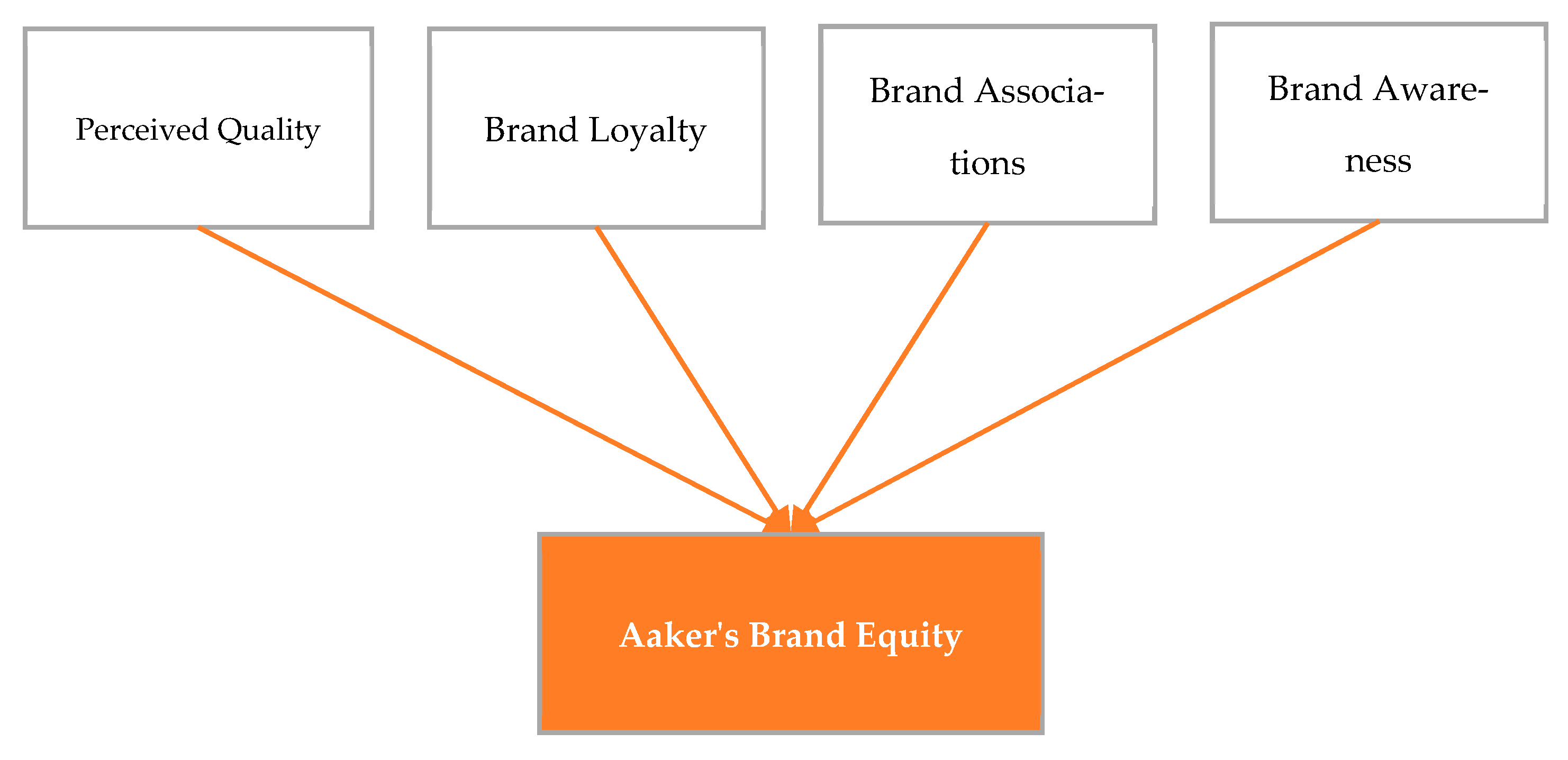
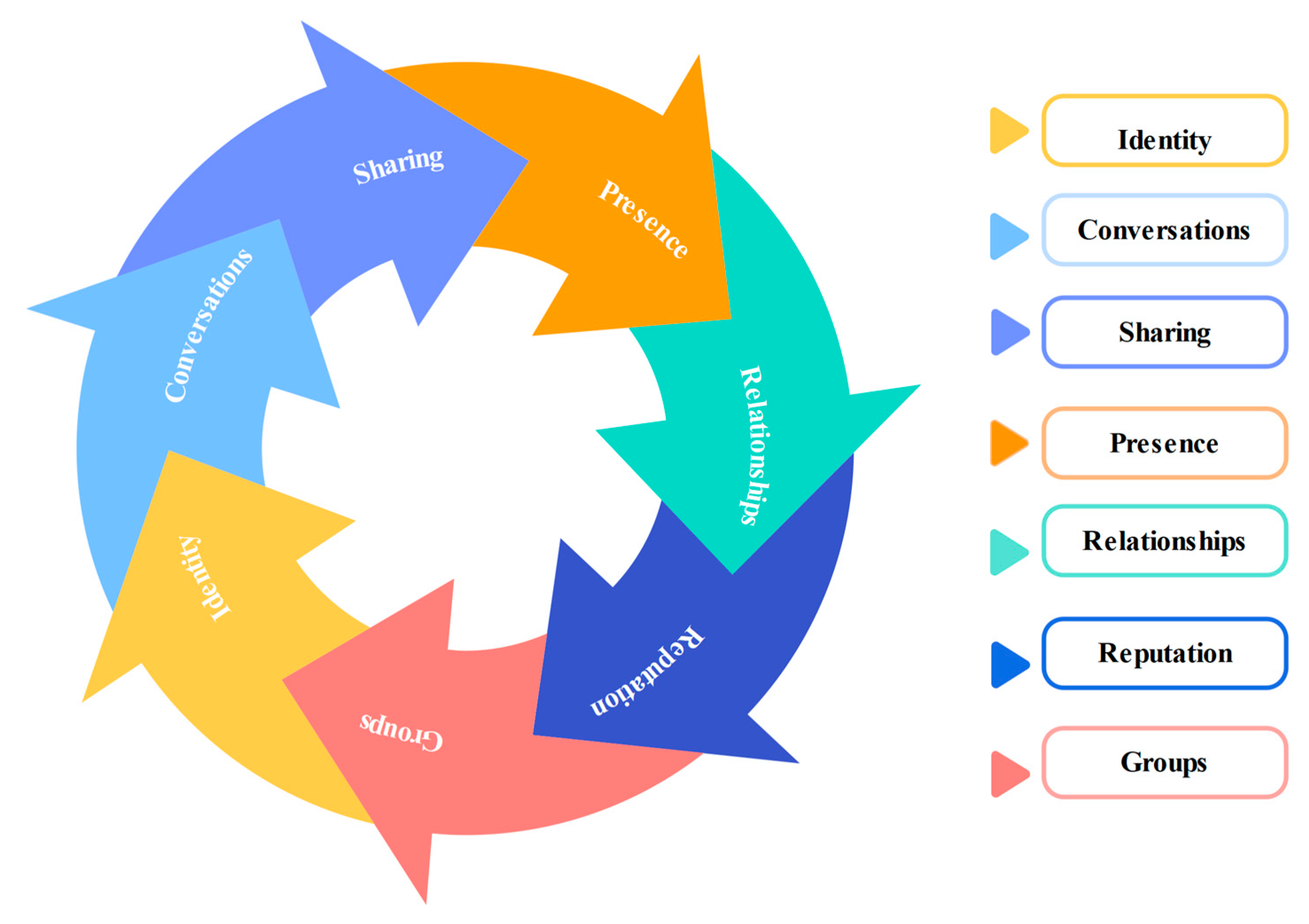
| Building Block | Description |
|---|---|
| Identity | Revealing a brand’s identity to others in different ways, depending on each user. |
| Conversations | Social network conversations reflect self-expression, status, and the desire to share fresh or valuable insights. |
| Sharing | Social networks facilitate the sharing, exchanging, and receiving of content among users. |
| Presence | Social media platforms enable users to signal their presence and availability. |
| Relationships | Social networks enable interaction, reflecting how closely users are connected to others. |
| Reputation | Social media users care about how they’re perceived, with reputation often tied to trust. |
| Groups | Social media groups reflect users’ fundamental need for belonging in online communities. |
Disclaimer/Publisher’s Note: The statements, opinions and data contained in all publications are solely those of the individual author(s) and contributor(s) and not of MDPI and/or the editor(s). MDPI and/or the editor(s) disclaim responsibility for any injury to people or property resulting from any ideas, methods, instructions or products referred to in the content. |
© 2025 by the authors. Licensee MDPI, Basel, Switzerland. This article is an open access article distributed under the terms and conditions of the Creative Commons Attribution (CC BY) license (https://creativecommons.org/licenses/by/4.0/).
Share and Cite
MohammadEbrahimzadeh, S.; Khajeheian, D.; Arbatani, T.R.; Labafi, S.; Sepasgozar, S. Sustainable Knowledge-Based Enterprise Products Using AI-Powered Social Media for Enhancing Brand Equity: A Scientometric Review. Sustainability 2025, 17, 8427. https://doi.org/10.3390/su17188427
MohammadEbrahimzadeh S, Khajeheian D, Arbatani TR, Labafi S, Sepasgozar S. Sustainable Knowledge-Based Enterprise Products Using AI-Powered Social Media for Enhancing Brand Equity: A Scientometric Review. Sustainability. 2025; 17(18):8427. https://doi.org/10.3390/su17188427
Chicago/Turabian StyleMohammadEbrahimzadeh, Sanee, Datis Khajeheian, Taher Roshandel Arbatani, Somayeh Labafi, and Samad Sepasgozar. 2025. "Sustainable Knowledge-Based Enterprise Products Using AI-Powered Social Media for Enhancing Brand Equity: A Scientometric Review" Sustainability 17, no. 18: 8427. https://doi.org/10.3390/su17188427
APA StyleMohammadEbrahimzadeh, S., Khajeheian, D., Arbatani, T. R., Labafi, S., & Sepasgozar, S. (2025). Sustainable Knowledge-Based Enterprise Products Using AI-Powered Social Media for Enhancing Brand Equity: A Scientometric Review. Sustainability, 17(18), 8427. https://doi.org/10.3390/su17188427







